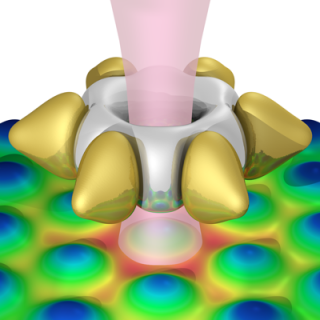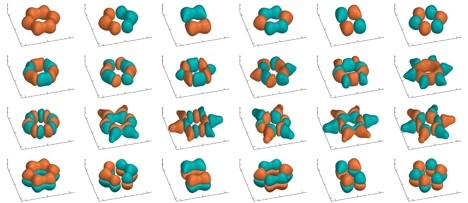Scientists propose molecular simulation with ultracold atoms. Determining the electronic structure and dynamics of molecular systems presents an intractable computational challenge for all but the simplest of molecules. Scientists surrounding CUI Professor Klaus Sengstock (Universität Hamburg) have proposed an approach to overcome the problem: They show that well-controllable atoms at ultra-cold temperatures can be used to simulate both the molecular orbitals and the electronic dynamics. The scientists present their work in the journal Physical Review X.

Schematic representation of the quantum simulator showing an artificial molecular orbital (center) and the optical potential (bottom). Credit: Dirk-Sören Lühmann (UHH)
Even though the molecular structure – the positions of the atoms in the molecule – is often well known, the molecular orbitals of the electrons have only been observed in very few exceptional cases. The scientists now propose a method to simulate molecules: In this setting, the ultra-cold atoms mimic the electrons in a molecule whereas a laser field takes the role of the atomic nuclei. This quantum simulation allows imaging the molecular orbitals with high resolution as demonstrated for benzene as an example.
Moreover, it is a long-standing dream to realize the direct imaging of the electron dynamics within molecules taking place on the femtosecond scale. As the scientists demonstrate, their “artificial molecules” offer deep insight into this dynamical evolution. The results pave the way to understanding fundamental open questions in molecular physics and testing various paradigms of quantum chemistry.

Illustration of orbitals in an artificial benzene molecule. Credit: Dirk-Sören Lühmann, Christof Weitenberg (UHH)
Citation:
Lühmann D.-S., Weitenberg Ch., and Sengstock K.
“Emulating Molecular Orbitals and Electronic Dynamics with Ultracold Atoms”
Phys. Rev. X 5, 031016 (2015)
DOI: 10.1103/PhysRevX.5.031016
News coverage: Science 349, 1298 (2015)

